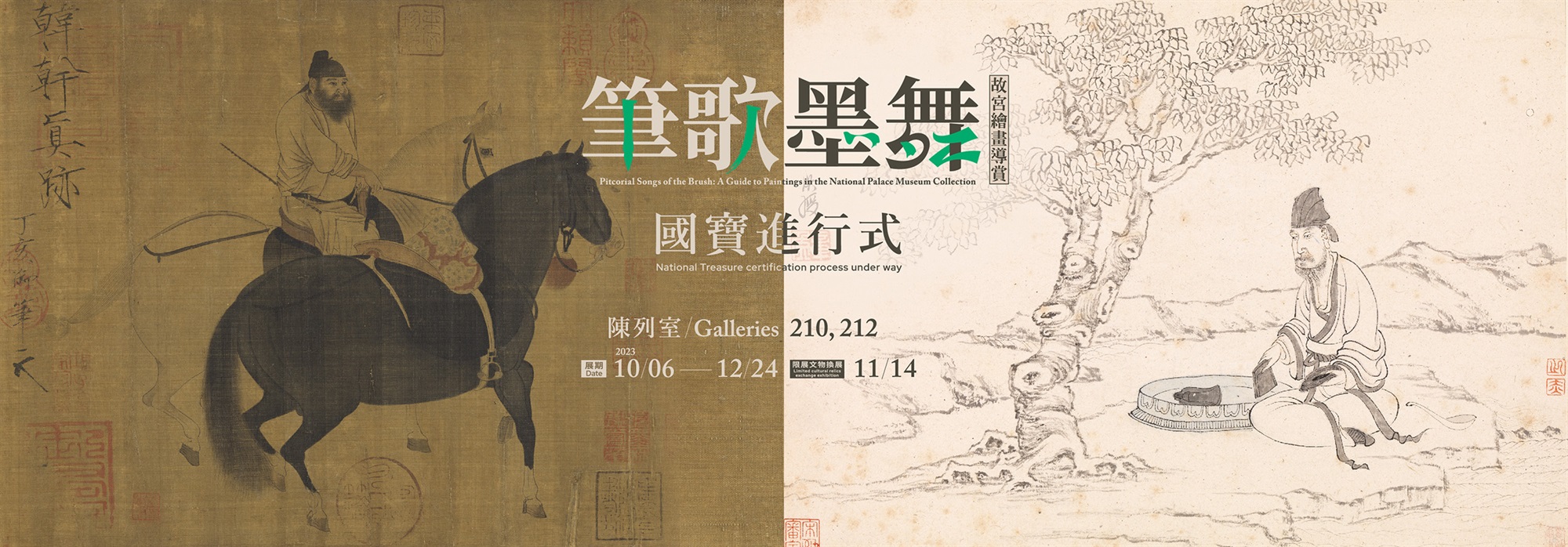Bird-and-Flower Painting
-
Flowering Reeds and a Pair of Swans, Anonymous, Song dynasty
White swans stand upon a reed-covered riverbank, one of them casually preening its feathers, the other craning its neck with its gaze fixed upon a kingfisher soaring by in the distance. The opposite bank is absent of any obvious texturing. In addition to using thick layers of semi-translucent ink washes to create negative space in the places where reed flowers were depicted with a dusting of snow, the artist also used white pigment to create realistic-looking snow and frost. Since the late Northern Song dynasty scenes depicting swans or geese in natural settings during autumn and winter have been a common sight—they symbolize love that does not fade even in the frigid bleakness of the bitterest winter. The creator of this work painted the swans’ forms with precision, outlining their plumage with such attention to detail that the various types of feathers on their heads, necks, scapulae, and tails—as well as the different feathers on the wings, including the lesser and median coverts, alula, and primaries—were all depicted in scale with accurate shapes and layering. The painting’s coloration is rich but simple, its subjects’ forms elegant and realistic. The birds’ appearances are vividly true to life, revealing the artist’s keen eye for observing nature. This piece is one of the finest works in the genre of flowers-and-birds painting to have been passed down through the centuries.
-
Black-naped Oriole on a Mulberry Branch, Anonymous, Song dynasty
Certified National Treasure
A black-naped oriole (Oriolus chinensis) alights on the branch of a mulberry tree, its head tilted back as it nibbles on a berry. Though the composition is sparsely pristine, it captures a fleeting moment through penetrating observations. Clear, distinctive coloration was applied to depict both the tree and the bird. The painted lines, which seem as though born of the very objects they portray, are extraordinarily natural and lifelike. The smooth parts of the bird’s plumage were primarily creating using evenly-applied linework with fluently painted outlines, while its down feathers were rendered with fine, stiff lines. The unevenness of the bark on the branches and the serrated edges of the mulberry tree’s leaves were painted with brushwork featuring striking turns and rises and falls of the brush’s tip. The theory and technique behind this kind of brushwork correlates with the views on painting-from-life that were current during Song dynasty emperor Huizong’s Xuanhe reign period (1100-1125). The imprint of a seal reading “Xuanhe” indicates that this painting was likely part of the imperial collection.
-
Colored Painting of Flowers and Plants, Chen Chun, Ming dynasty
Chen Chun (1483-1544), who came from Changzhou (present day Suzhou), had the style name Daofu and the sobriquet “Recluse of Baiyang Mountain” (Baiyang Shanren). Chen studied painting under Wen Zhengming (1470-1559) for a period of time, earning his teacher’s deepest approbations.
This painting features supremely exquisite brushwork and coloration. Set in the most sweltering, humid days of summer, the work depicts blossoming plants trying to outcompete one another with the glory of their hues and loveliness of their fragrances. The five types of flowers in bloom atop the Taihu stone include cape jasmine, rose, lily, China pink, and red peonies. Chen primarily painted the plants and their flowers using the “boneless” technique, but the cape jasmine and lily flowers were painted with the double outline method, while their leaves were painted directly. In order to portray this profusion of flowering garden plants, Chen used a warmly refined selection of colors that speaks to highbrow sensibilities and seems almost to perfume the painting with floral scents.
-
Painting from Life, Chuanqi, Qing dynasty
Chuanqi (1626-1705), also known as Bada Shanren, had the surname Zhu and the given name Da. A member of the Ming dynasty imperial clan who was born in Nanchang, Jiangsu province, Zhu shaved his head and became a Buddhist monk after the dynasty collapsed. He was a skilled poet and an excellent calligrapher.
According to the date provided on the final leaf of this album, it was produced in the ji-hai year (1659), when Chuanqi was thirty-four years old and in the prime of his life. This album comprises ink wash portrayals of vegetables, flowering plants, calabashes, and decorative stones. They are all abundantly transformative, painted with a fast-moving brush, and composed in an unconventional manner. While the influence of Ming dynasty paintings-from-life remains evident in these paintings, Chuanqi tailored these influences so as to avoid descending into cliché, while also eschewing with the pursuit of completeness and finality in the images. Not only do these choices reflect the painter’s independent streak, they foreshadow developments that came later in his artistic career.


